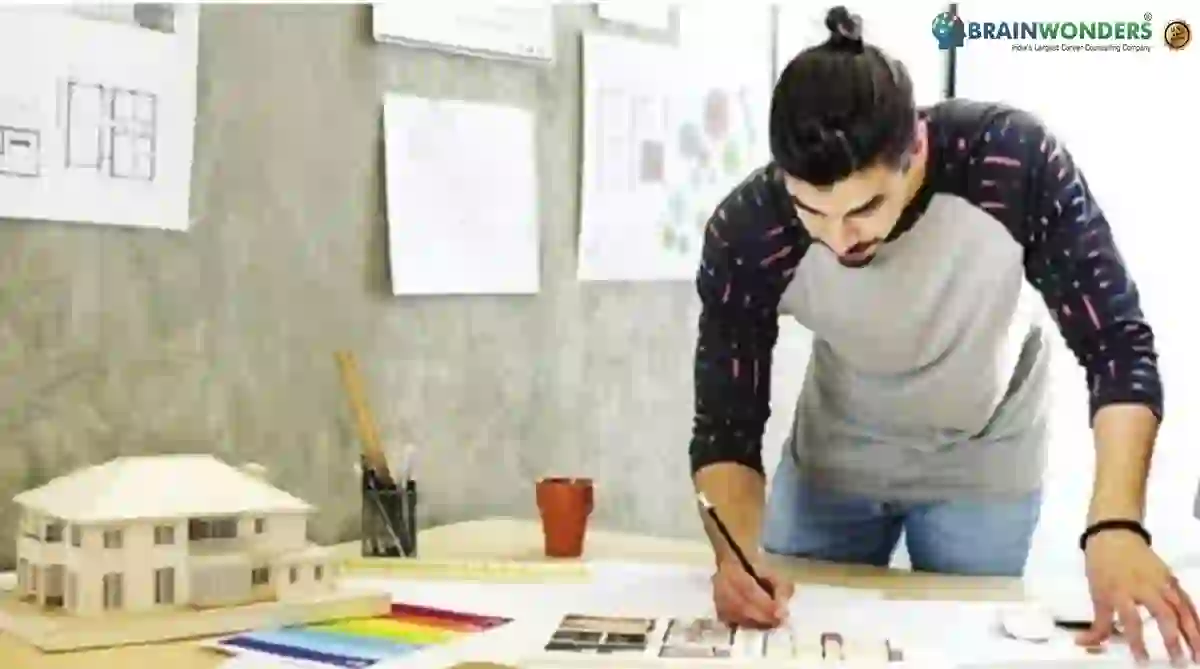How to become an Interior Designer
Overview, Courses, Exam, Colleges, Pathways, Salary

Overview
Who is Interior Designer ?
Interior designers work on many different projects that help them make a living and work areas that are beautiful and functional. They use both visual aesthetics and practical utility to build a comfortable space that best uses the space. They are a part of the projects from the beginning of the design's development to the end of the project. They also make sure that the design plans align with the building codes and regulations set by law.
For any business or home, an interior designer helps plan the layout and structure of the space and the finer details like colour schemes, furnishings, lighting, ventilation, decorative items, furniture, wall finishes, and flooring. When they do this, they think about the client's needs, preferences, budget and the building codes and laws in the area where they live. In addition, they work with architects, civil engineers, and construction workers to make sure each project is done on time and within budget.
Typical day at work
What does Interior Designer do?
- Understand the client’s requirements regarding the utilities and functionality as well as the colour scheme, decorations, lighting, and visual appeal
- Define the project requirements and develop design concepts as per the client’s needs
- Sketch the project ideas as preliminary designs plans and produce construction schedules
- Present the design ideas through digital presentations to convey the design plans
- Specify and source materials and products that shall be required for the project as per the design plans
- Provide estimates of the project costs and ensure it is within the client’s budget
- Maintain thorough documentation regarding all activities of the project
- Coordinate the logistics aspects of product delivery and oversee the installation of design materials
- Oversee the work of the construction labourers to ensure the implementation is consistent with the design plans
Abilities and Aptitude needed
What are the skills, abilities & aptitude needed to become Interior Designer?
An interior designer must be very creative and be able to imagine and sketch design plans in a way that looks good. He or she should understand the technical aspects of reading blueprints and planning space practically. Working knowledge of the computer-aided design (CAD) software used to make and show designs will be needed, such as Autodesk Revit, SketchUp, Vector Works, Archicad, and AutoCAD. One of the essential parts of this job is the interior designer's sense of style, including colour schemes, decoration, and furniture. In addition, they should know how to use different materials and how to build things so that their designs fit the client's budget.
They need to communicate well with the client to work together to figure out what the client wants, needs and wants about the space's utility and aesthetics, and then meet or exceed those needs, preferences, and expectations. They also have to be good at working with other people, which means they need to be good at teamwork. Interior designers need to be very organised and good at time management to make their work go as quickly as possible. They should be informed on developing industry trends.
Salary
Salary for Interior Designer?
Salary information for an Interior Designer in India:
- Minimum Monthly Salary: For entry-level Interior Designers or those starting their careers, the monthly salary may range from INR 15,000 to INR 25,000, especially when working for smaller design firms or on low-budget projects.
- Maximum Monthly Salary: Established and highly successful Interior Designers with a strong portfolio and reputation can earn a maximum monthly salary of INR 1,00,000 to INR 2,00,000 or more, particularly when working on high-end residential or commercial projects.
- Annual Salary: The annual salary of an Interior Designer can be from INR 2,00,000 to several lakhs, depending on factors such as experience, client base, and the scale of projects undertaken.
- Highest Paying Job and Scope: The highest paying job for an Interior Designer is often found in senior positions within renowned design firms, luxury hospitality projects, or high-profile celebrity clients. Interior Designers with a successful track record of delivering exceptional and innovative designs can command higher fees for their services.The scope for Interior Designers in India is promising as the demand for aesthetically pleasing and functional spaces grows. Interior Designers work on various projects, including residential interiors, commercial spaces, hospitality establishments, retail stores, healthcare facilities, and public spaces.
Pathways
How to become an Interior Designer?
Entrance Exam
Entrance Exam for Interior Designer ?
NID 2020 (National Institute of Design) conducts the DAT (Design Aptitude Test) Prelims and Mains for providing admissions in various UG and PG courses in the field of design. Some colleges also give admission on the basis of the merit list of the qualifying examination. As part of the admission test candidates need to first appear for a design aptitude test and thereafter submit their portfolio.
There is provision of entrance test before the admission in interior designing. Candidate must have to collect the portfolio to represent at the time of admission. It will allow the opportunity to get admission. Here we are providing the list of entrance test conducted for admission in design courses:
- UCEED 2020
- CEED 2020
- NIFT Exam 2020
- AIEED
- GD Goenka DAT
- CEPT Entrance Exam
- Pearl Academy Entrance Exam
- SEED
- NID Entrance Exam
- ISDI Entrance
- MIT Institute of Design entrance
- JIMS Entrance Test
Courses
Which course I can pursue?
Best Colleges
Which are the best colleges to attend to become an Interior Designer?
Industries
Which Industries are open for Interior Designer?
- Public and private sector establishments
- Work with architects and architectural firms
- Hospitals and other medical facilities
- Town and city planning bureaus
- Hotels
- Health resorts
- Work with renowned builders
- Design studios
- Exhibition organizers
- Event management companies
internship
Are there internships available for Interior Designer?
Internships for Interior Designers are widely available and can provide valuable hands-on experience and exposure to interior design. Aspiring interior designers can find internship opportunities in various settings, including:
- Interior Design Firms: Many interior design companies and firms offer internship programs for students or recent graduates to work on real projects and learn from experienced designers.
- Architectural Firms: Architectural firms often have interior design departments and may offer internships to individuals interested in the interior design aspect of architectural projects.
- Home Décor Retailers: Home décor and furniture retailers may offer internships in their interior design departments to assist customers with design ideas and solutions.
- Hospitality Industry: Hotels, restaurants, and other hospitality establishments may offer interior design internships for individuals interested in commercial and hospitality design.
- Residential Construction Companies: Companies specializing in residential construction may have interior design internship opportunities to work on residential projects.
- Event Management Companies: Event management companies may offer interior design internships to assist with designing event spaces and settings.
- Interior Design Magazines and Publications: Interior design magazines and media outlets may have internship programs for individuals interested in editorial design and content creation.
- Corporate and Commercial Spaces: Corporations and businesses may offer interior design internships for individuals interested in office and commercial space design.
- Real Estate Companies: Real estate companies may offer interior design internships to assist with staging and preparing properties for sale.
- Furniture and Product Design Companies: Companies involved in furniture or product design may have interior design internships focused on product presentation and design.
Career outlook
What does the future look like for Interior Designer?
Interior Designing has become an increasingly popular career choice in India in recent times. The evolving lifestyle of the people has increased the demand for interior designers to upgrade spaces and tackle space crises. They are involved in a range of projects aimed at renovation or remodelling of existing structures or constructing new spaces. They can specialize in designing particular types of structures, including corporate, healthcare, kitchen and bath.
They are typically employed by homeowners, design service firms, architectural firms, construction companies, and furniture stores. They typically work from offices with standard business hours. However, they may need to frequently adjust their working hours to meet the client’s schedules and deadlines. They are required to travel to the project sites occasionally to oversee the execution of their design plans. Many interior designers choose to work independently as consultants on a contractual basis as well.



